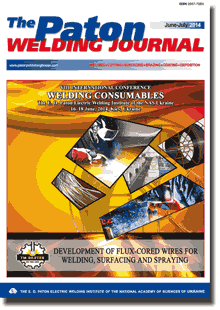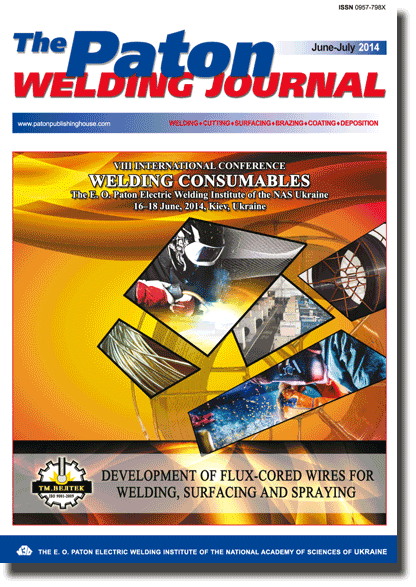Access for download PDF files for subscribers and for reviewers of scientometric bases.
Organization: Elsevier for content access(PDF files of journals released before 2024 are available for download from the website's archives))
Organization: Elsevier for content access(PDF files of journals released before 2024 are available for download from the website's archives))
| 2014 №06 (35) |
DOI of Article 10.15407/tpwj2014.06.36 |
2014 №06 (37) |

The Paton Welding Journal, 2014, #6-7, 163-171 pages
EFFECT OF CHARGE GRAIN COMPOSITION ON RHEOLOGICAL CHARACTERISTICS AND STRUCTURE OF PRESSURE FLOW OF COMPOUNDS FOR LOW-HYDROGEN ELECTRODES
A.E. MARCHENKO
E.O. Paton Electric Welding Institute, NASU. 11 Bozhenko Str., 03680, Kiev, Ukraine. E-mail: office@paton.kiev.ua
Abstract
It is determined in course of investigation of compound of low-hydrogen electrodes UONI-13/55, carried out with the help of capillary viscosimeter, that their rheological indices and structure under flow pressure condition significantly depend on grain composition of coating materials. Charge should contain 50% of fine fraction from point of view of minimizing of energy consumption, necessary for extrusion application of compounds on rods. Deviation of its portion in one or another side from indicated optimum significantly rises energy consumption on electrode extrusion. The compounds with fine- or coarse-grain filler are not similar to each other on structure. It confirms nature of change of level of compound dissipative heating, value of natural convergence angle in entrance zone (to capillary) as well as shape of deformation (extrusion) curves at increase of flow velocity. Profile of flow of compounds with coarse-grain filler expands at rise of pressure jet rate. It remains virtually of the same narrow shape as at creep flow velocities for flow of compounds with fine-grain filler. The results of analysis of form of extrusion curves P = f(t) indicate that pressure flow of compound with coarse-grain filler is realized on viscosity mechanism. The compounds with excessive content of fine-grain filler are more structured, since liquid glass binder in these cases in addition to filling of intergrain voids should cover significantly more developed grain surface. Rise is observed in their molecular interaction and strength of structure formed by them, which is fractured in deformation and accompanied by specific phenomena of unsteady flow. 8 Ref., 2 Tables, 8 Figures.
Keywords: low-hydrogen welding electrodes, coating thickness difference, rheology of compounds, viscosity and elasticity indices of compounds
Received: 15.04.14
Published: 28.09.14
References
1. Marchenko, A.E., Pokhodnya, I.K., Skorina, N.V. et al. (1994) Development of technology for manufacture of low-carbon electrodes. Svarochn. Proizvodstvo, 5, 14-18.
2. Marchenko, A.E. (1978) On rheological methods of evaluation of technological properties of electrode compounds: SMEA Inform. Doc., Issue 1, 121-128. Kiev: Naukova Dumka.
3. Marchenko, A.E. (2013) Examination of concentrated suspensions of marble in liquid glass as a rheological model of electrode compounds. In: Proc. of 7th Int. Sci.-Techn. Conf. on Welding Consumables. Arc Welding. Materials and Quality (Krasnodar, vil. Agoj, 17-21 June 2013), 98-115.
4. Marchenko. A.E., Gnatenko, M.F. (1980) Peculiarities of flow of electrode compounds detected by capillary plastometer: SMEA Inform. Doc., 106-117. Kiev: Naukova Dumka.
5. Marchenko, A.E. (2011) About rheological properties of electrode compounds in convergent zone during electrode extrusion. In: Proc. of 6th Int. Conf. on Welding Consumables. Development. Technology. Manufacture. Quality. Competitiveness (Krasnodar, 6-9 June 2011), 223-232.
6. Cogswell, F.N. (1972) Converging flow of polymer melts in extrusion dies. Polymer Eng. and Sci., 12(2), 64-70. https://doi.org/10.1002/pen.760120111
7. Belkin, I.M., Vinogradov, G.V., Leonov, A.I. (1967) Rotary devices. Measurement of viscosity and physico-mechanical characteristics of materials. Moscow: Mashinostroenie.
8. Moshev, V.V. (1977) Viscosity principles of highly filled polymers. In: Rheology (polymers and petroleum): Transact. of All-Union school on rheology, 53-64. Novosibirsk: ITF.
Suggested Citation
A.E. MARCHENKO (2014) EFFECT OF CHARGE GRAIN COMPOSITION ON RHEOLOGICAL CHARACTERISTICS AND STRUCTURE OF PRESSURE FLOW OF COMPOUNDS FOR LOW-HYDROGEN ELECTRODES. The Paton Welding J., 06, 163-171.The cost of subscription/purchase order journals or individual articles
| Journal/Currency | Annual Set | 1 issue printed |
1 issue |
one article |
| TPWJ/USD | 384 $ | 32 $ | 26 $ | 13 $ |
| TPWJ/EUR | 348 € | 29 € | 24 € | 12 € |
| TPWJ/UAH | 7200 UAH | 600 UAH | 600 UAH | 280 UAH |
| AS/UAH | 1800 UAH | 300 UAH | 300 UAH | 150 UAH |
| AS/USD | 192 $ | 32 $ | 26 $ | 13 $ |
| AS/EUR | 180 € | 30 € | 25 € | 12 € |
| SEM/UAH | 1200 UAH | 300 UAH | 300 UAH | 150 UAH |
| SEM/USD | 128 $ | 32 $ | 26 $ | 13 $ |
| SEM/EUR | 120 € | 30 € | 25 € | 12 € |
| TDNK/UAH | 1200 UAH | 300 UAH | 300 UAH | 150 UAH |
| TDNK/USD | 128 $ | 32 $ | 26 $ | 13 $ |
| TDNK/EUR | 120 € | 30 € | 25 € | 15 € |
AS = «Automatic Welding» - 6 issues per year;
TPWJ = «PATON WELDING JOURNAL» - 12 issues per year;
SEM = «Electrometallurgy Today» - 4 issues per year;
TDNK = «Technical Diagnostics and Non-Destructive Testing» - 4 issues per year.


